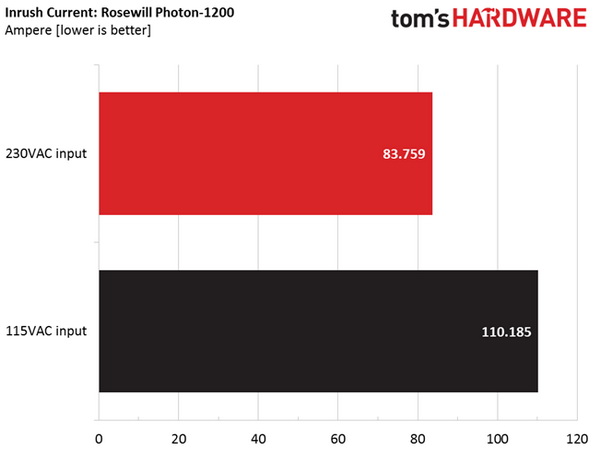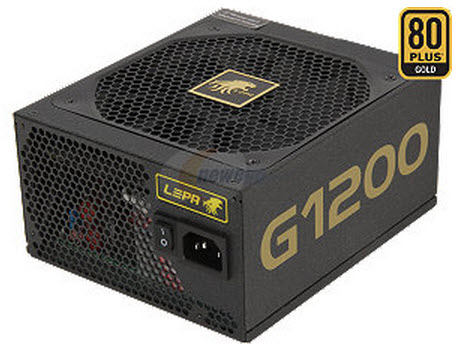Rosewill Photon-1200 PSU Review
Today, we evaluate Rosewill's Photon-1200, manufactured by Sirfa, featuring fully modular cabling, Gold-rated efficiency and a high watt-per-dollar ratio.
Why you can trust Tom's Hardware
Load Regulation, Hold-Up Time And Inrush Current
To learn more about our PSU tests and methodology, please check out How We Test Power Supply Units.
Primary Rails And 5VSB Load Regulation
Load Regulation testing is detailed here.








Hold-Up Time
Our hold-up time tests are described in detail here.


The Photon-1200's hold-up time easily surpasses the minimum allowed by the ATX spec.
Inrush Current
For details on our inrush current testing, please click here.


The inrush current that our shiny, new power meter (N4L PPA1530) measured is very high, especially with 115V. Sirfa should make the necessary changes to fix this.
Load Regulation And Efficiency Measurements
The first set of tests reveals the stability of the voltage rails and the PSU's efficiency. The applied load equals (approximately) 10 to 110 percent of the supply's maximum in increments of 10 percentage points.
Get Tom's Hardware's best news and in-depth reviews, straight to your inbox.
We conducted two additional tests. During the first, we stressed the two minor rails (5V and 3.3V) with a high load, while the load at +12V was only 0.10A. This test reveals whether a PSU is Haswell-ready or not. In the second test, we determined the maximum load the +12V rail could handle with minimal load on the minor rails.
| Test | 12V(A/V) | 5V(A/V) | 3.3V(A/V) | 5VSB(A/V) | PowerDC/AC(W) | Efficiency(%) | Fan Speed(RPM) | Fan NoisedB(A) | TempIn/Out(°C) | PF/AC (V) |
|---|---|---|---|---|---|---|---|---|---|---|
| 1 | 7.986A | 1.932A | 1.959A | 0.971A | 119.75 | 85.62 | 1630 | 55.7 | 40.07 | 0.899 |
| 12.296V | 5.164V | 3.367V | 5.134V | 139.86 | 42.20 | 115.1V | ||||
| 2 | 17.008A | 2.907A | 2.944A | 1.170A | 239.67 | 89.59 | 1690 | 55.6 | 41.35 | 0.928 |
| 12.276V | 5.157V | 3.360V | 5.121V | 267.51 | 43.76 | 115.1V | ||||
| 3 | 26.421A | 3.393A | 3.455A | 1.369A | 359.84 | 90.53 | 1730 | 55.1 | 41.64 | 0.948 |
| 12.255V | 5.149V | 3.354V | 5.108V | 397.48 | 44.31 | 115.1V | ||||
| 4 | 35.837A | 3.882A | 3.939A | 1.568A | 479.61 | 90.58 | 1780 | 54.3 | 43.16 | 0.961 |
| 12.235V | 5.143V | 3.348V | 5.095V | 529.51 | 46.36 | 115.1V | ||||
| 5 | 44.954A | 4.867A | 4.936A | 1.768A | 599.53 | 90.21 | 1820 | 54.5 | 44.02 | 0.969 |
| 12.214V | 5.134V | 3.341V | 5.083V | 664.60 | 47.58 | 115.1V | ||||
| 6 | 54.107A | 5.848A | 5.932A | 1.970A | 719.43 | 89.62 | 1830 | 54.6 | 44.61 | 0.974 |
| 12.192V | 5.126V | 3.336V | 5.072V | 802.76 | 48.68 | 115.1V | ||||
| 7 | 63.271A | 6.834A | 6.932A | 2.170A | 839.12 | 88.85 | 1830 | 54.6 | 45.46 | 0.978 |
| 12.171V | 5.118V | 3.331V | 5.059V | 944.40 | 50.17 | 115.1V | ||||
| 8 | 72.509A | 7.831A | 7.940A | 2.374A | 959.21 | 87.94 | 1830 | 54.6 | 46.86 | 0.981 |
| 12.148V | 5.108V | 3.324V | 5.045V | 1090.75 | 51.97 | 115.1V | ||||
| 9 | 82.183A | 8.333A | 8.470A | 2.379A | 1079.08 | 87.02 | 1830 | 54.6 | 48.28 | 0.982 |
| 12.125V | 5.102V | 3.318V | 5.040V | 1240.07 | 53.69 | 115.1V | ||||
| 10 | 91.239A | 8.833A | 8.970A | 4.020A | 1198.94 | 85.71 | 1830 | 54.6 | 49.16 | 0.984 |
| 12.103V | 5.093V | 3.311V | 4.972V | 1398.88 | 54.85 | 115.1V | ||||
| 11 | 101.338A | 8.844A | 8.986A | 4.025A | 1318.95 | 85.06 | 1830 | 54.6 | 49.34 | 0.984 |
| 12.081V | 5.087V | 3.305V | 4.968V | 1550.57 | 55.48 | 115.1V | ||||
| CL1 | 0.099A | 16.020A | 16.000A | 0.001A | 137.13 | 80.93 | 1830 | 54.6 | 46.03 | 0.907 |
| 12.299V | 5.136V | 3.352V | 5.177V | 169.44 | 50.39 | 115.1V | ||||
| CL2 | 99.944A | 1.002A | 1.003A | 1.002A | 1222.26 | 86.04 | 1830 | 54.6 | 50.67 | 0.983 |
| 12.094V | 5.110V | 3.319V | 5.081V | 1420.63 | 57.23 | 115.1V |
Load regulation isn't bad, but it's not top-notch, either. Let's call it somewhere between good and bad. Compared with the more expensive PSUs in this category, the Photon-1200 doesn't score well. The supply does deliver its full power for prolonged periods, even at operating temperatures close to 50 °C (122 °F). However, this result wasn't achieved without problems, as you will see from the ripple results we measured. So, if you're building a power-hungry system with this PSU, keep its operating temperature below 40 °C (104 °F).
The situation gets worse when we start looking at noise output. Even at light loads, high ambient temperatures cause the fan to get really loud. Also, as you can see from the table above, it has significant bearing noise at around 1600 RPM where its acoustic output peaks. The inefficient platform doesn't leave room for a more relaxed fan profile.
Current page: Load Regulation, Hold-Up Time And Inrush Current
Prev Page A Look Inside And Component Analysis Next Page Efficiency, Temperature And Noise
Aris Mpitziopoulos is a contributing editor at Tom's Hardware, covering PSUs.
-
MasterMace Sirfa has produced too many poor units in the past to get any leeway or benefit of the doubt. It failed 80 Plus Gold in the hotbox at 100% load.Reply -
boller I have a good perspective on that ripple thing: just finished repairs of a PC power supply and when I was measuring ripple I found it was out of whack (300 mV pp). After some investigation I found out that measuring ripple is a tricky thing. Tom's description on how they do it is very incomplete. Eevblog guy spent an entire episode on ripple. In my case I had to do this: limit oscilloscope bandwidth 20 MHz, instead of the grounding clip use that spring attachment and measure loaded PSU at the last cap before leads. Ripple went down from 300 to 48 mV pp.Reply -
Aris_Mp First of all you don't just hook a scope on a PSU's output and measure ripple else you will catch huge spikes, like in your case, which will totally alter the measured result.Reply
Secondly most users aren't interested on how I do things (and even if I elaborated on all the procedures I follow only a fraction of them would understand them) but about the final result. For me the most important is to explain what ripple is and how it can affect the components of a system.
Thirdly. You don't have to watch Dave to see how ripple is measured properly. You can check on the ATX spec which includes the ripple measurement procedure. I follow all guidelines of the ATX spec so if you need to see how I measure ripple or load regulation just take a look at them. In any case the following scheme will show you how to measure ripple on a PSU.
-
boller No need to be defensive, I was just pointing out that your _description_ is incomplete, not that you do it wrong. Although it would be nice for you to place a note over there saying that actual procedure involves some additional caps and an honest to god differential probe (!)Reply -
Aris_Mp I just replied to your concerns. No need to think that I am defensive because clearly this is not the case with me.Reply
I already stated that I don't mention how I measure ripple since among others all of us reviewers have to follow the ATX spec procedure. There is no point in repeating the whole ATX spec from the moment that anyone can download and read this spec with a simple google search.
Besides these two caps (which are already pre-installed on the fixtures that most of us reviewers have. There also present on loaders like the Sunmoon ones) and the good quality probes you also need to isolate all external noise that can pass from the PSU's EMI filter. In other words you need to provide "clean" power to the PSU. Personally I do this with a Chroma AC source and in the near future I plan to get a online UPS with some extra circuits for EMI/noise protection which will feed the AC source (so I will have two layers of protection). In order to check if your line is clean firstly take some readings on the major rails (+12V, 5V and 3.3V) with the PSU in standby. If you see increased ripple (normally it should be close to zero mV) then your scope picks up noise or the PSU isn't properly isolated from the rest devices on your home/lab. -
CTurbo It's not a bad unit, but it's not competitive at all. It's more expensive than an EVGA G2 1300w Gold and and Rosewill Capstone 1200w Gold, and almost as much as an EVGA P2 1200w. Yikes!Reply -
Mac266 Shame it performed badly, a cheap high rated supply could stir the market up nicely!Reply
It's not a bad unit, but it's not competitive at all. It's more expensive than an EVGA G2 1300w Gold and and Rosewill Capstone 1200w Gold, and almost as much as an EVGA P2 1200w. Yikes!
CTurbo! How ya been mate?


